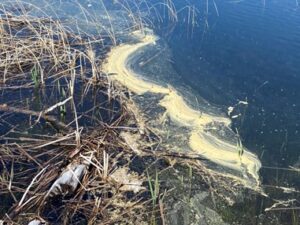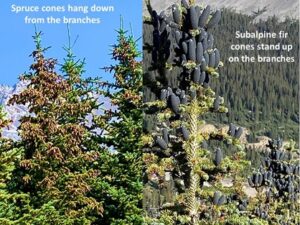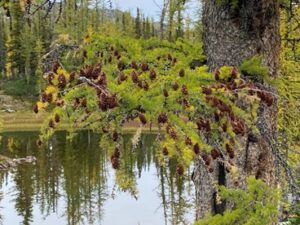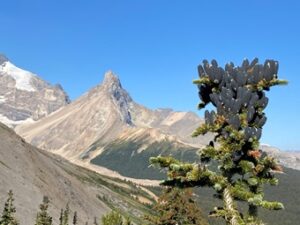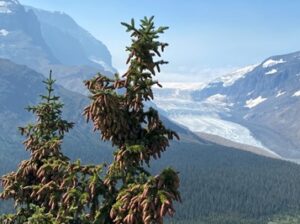By Jenny L. Feick, PhD
All pictures taken by the author unless otherwise noted.
Anyone hiking on Canada’s Great Divide Trail in the summer of 2022 could not help but notice the prolific cone crop on the spruce and fir trees along the GDT. In fact, anyone hiking in the Canadian Rockies and Columbia Mountains of Western Canada or along the Continental Divide Trail in the U.S.A., likely saw this same spectacle. Some spruce trees became so overloaded with cones that they bent over with the weight and in a few cases, their tops actually broke off! All summer, I heard people propose various ideas to account for the copious cone crop. If you are curious about cones and what caused this surfeit (as well as what didn’t), read on.

Cones Clarified
Conifer means “cone-bearing” in Latin. Conifer trees produce both male (pollen) and female (seed) cones. The smaller pollen-bearing cones tend to develop on the lower branches of conifers. The larger seed cones usually grow in the upper portions of the trees. This placement reduces the likelihood of self-pollination and facilitates genetic diversity.
The male cones produce the massive number of pollen grains that get released and carried on the wind, some of which lands on the seed cones. Different species employ different techniques to facilitate bringing the pollen to where it can fertilize ovules, the unfertilized seeds in the female cones. Subalpine firs use rainwater whereas pines exude an aqueous drop. No quickies for conifers; the time from pollination to fertilization can exceed a year! Most conifer pollen carpets bodies of water, bare earth, and other vegetation. When inhaled from the air, conifer pollen can cause allergic reactions in some people, aggravating underlying conditions such as asthma.
The female cones develop and hold the seeds containing the fertilized embryos that propagate the species. The conifers’ woody reproductive organs tend to have a conical or round-shape, the exact configuration and orientation varying with the species.
Once pollinated, the tree’s female cones develop as the seeds mature. The cones serve as protective coatings for the seeds, shielding them from water, wind and harsh conditions. The individual plates on the female cones, known as scales, help to protect the seeds from weather extremes until suitable conditions arise to release them.

Some species of conifer disperse their seeds by wind; others by animals. Eventually these seeds reach the ground, some in suitable spots. Most cool temperate conifer species require a cold moist winter period to “stratify” them before they will germinate. After the embryo in the seed absorbs water, a seedling root breaks through the seed coat and turns down into the soil. The shoot grows up toward the light. Needle-shaped juvenile leaves densely clothe the seedling shoot until the adult needle-like foliage forms, the time varying with the species. These seedlings become saplings and eventually conifer trees, unless they get pruned by a GDTA volunteer or munched on by a mule deer or snowshoe hare, that is.

Many conifer species have evolved ingenious means to help deter hungry conifer seed-eating animals such as various bird species and squirrels, including sealing the cones with a hard serotinous resin or pitch, varying the number of cones produced each year, varying seed maturation among individual trees of the same species in a given year, or “flooding the market” by synchronously opening all cones on each tree in a given area. In general, conifers try to do two things: 1) deter animals like red squirrels that tend to harvest “green” seed cones before they fully ripen, thus drastically lessening the likelihood of any harvested seeds germinating; and 2) encourage harvest by animals like the Clark’s nutcracker that harvests ripe seeds, thus facilitating seed dispersal.
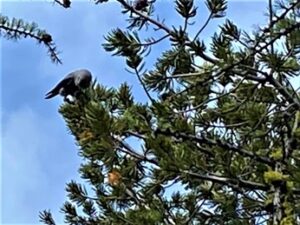
Fertilization and seed development takes a long time in conifers. Just the pollination process[1] can take up to a year, depending on the species and environmental conditions. Then it may take up to two years after pollination for the seed cones to fully develop to the point where seeds are ready to be released. So, what we see in 2022 reflects a process that has been going on for the last two to three years.
Conifers Are Not Fortune Tellers
Given that, let’s dispel a few myths about conifer cone production. Conifers do not produce more cones, or bigger cones, or cones higher up on the tree, because they “know” that the upcoming winter is going to be especially harsh. The trees do not make more cones because they “want” to ensure there are enough of their seedlings next spring given the upcoming frigid conditions. Conifers do not sense in advance that squirrels and birds will gather and cache more cones and eat more of their seeds than usual during a colder than normal winter.
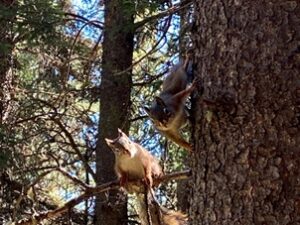
Tree Tango?
Conifers and the animal species that eat their lipid and protein-rich seeds have executed a complicated co-evolutionary dance. To stymie seed predators, certain conifer species exhibit cyclical cone production (abundant in some years, few in others, and then a bumper crop again some number of years later). This production of many seeds by a plant every two or more years in regional synchrony with other plants of the same species is called mast seeding or “masting” and is a predator satiation technique. Since seed predators commonly scour the ground and treetops for each year’s seed crop, they usually eat most of the seeds produced by many different plant species every year. Mast seeding can be an effective defense because the seed predators become satiated before all the seeds have been consumed.
Much research has been conducted on masting cycles as a technique to alternately starve and overwhelm seed predators. Dr. Stan Boutin, professor emeritus from the University of Alberta in Edmonton, is one of the Canadian scientists who has studied this phenomenon. Following a paper he delivered in October 2022 at a research forum[2], he told me that these masting cycles appear to be getting shorter over time (from every seven to ten years to every two to three years). He suspects that temperature plays a role in this. Warmer than usual temperatures during cone development may be what triggers an earlier masting event.
A recent summary of numerous studies between 1972 and 2018[3] found evidence of satiation during mast years and starvation in the intervening periods. They concluded that seed consumers showed both a functional and a numerical response to masting, with the two effects reinforcing each other. The satiation technique appeared more obvious at higher, temperate, and boreal latitudes since masting reduces seed losses more effectively in less diverse plant communities. The studies showed that masting satiated invertebrate seed predators like wasps and beetles but not vertebrates such as deer mice and American red squirrels. Incidentally, each red squirrel, which lives on average from three to ten years in the wild, annually needs to consume the seeds from 20,000 cones, or between 60,000 and 200,000 cones in its lifetime!
The mast seeding approach has implications for the organization of conifer forests. Instead of a few new seedlings establishing themselves each, major pulses occur over time, during which new seedlings and saplings become established and old conifer trees die.
It is possible that the widespread efflorescence or “sudden flowering” of cones in white and Engelmann spruce, subalpine fir, Douglas-fir and subalpine larch that we saw in 2022 relates to the masting cycles of these species, which vary. The effect did not seem to be as pronounced in lodgepole, whitebark and limber pines, which would have different masting cycles. Also pines rely on armouring their cones with resin to discourage seed predators like red squirrels rather than just variable and synchronous reproduction. They may also be reflecting their recent past.
So, why the mass production of cones in 2022?
Coniferous trees cannot predict the future. What they can reveal includes information about past climatic and environmental factors, such as average annual temperature, moisture, and the availability of key soil nutrients like the ratio of soil carbon to nitrogen. Studies of pine tree reproduction show that it relates to fire cycles. Weather factors like temperature and water availability also affect cone and seed development.
In some areas with marginal conditions for conifers, a big cone crop can mean that the trees have experienced two successive seasons with optimum conditions. Or, it could mean that the trees are stressed.
If conifers could talk, they would never say, “Sorry, not tonight dear; I’ve got a headache.” Unlike certain humans whose libido decreases when they feel stressed, revved up reproduction in response to stress is a common reaction for plants, including conifers. Stressed trees go into a seed-producing frenzy. Conifers produce more cones following insect defoliation, drought, and wounds to the outer layers of bark. The term used by arborists and foresters for this is a “stress crop”.
Over the 150 million years that conifers have existed on our planet, they evolved an intricate web of complex mechanisms to translate the stress signals they receive into a biologically effective response. In response to dehydration, herbivory, scarring, or other threats, conifers can modify their gene expression or directly alter their cell physiology. Specifically, in a stressed conifer, the needles, bark, and/or roots release one of several hormones (e.g., ethylene or abscisic acid) that then cause the tree to begin producing one or more different types of gibberellins, a plant hormone associated with intense cone production. Stress in conifers causes a rise in the level of gibberellin, which in turn causes cones to form. Stressed trees may divert energy towards a plentiful cone crop as a “last gasp” before they die as a way to ensure species survival. The year after a major cone crop, the tree produces few if any cones, focusing its now depleted energy stores on survival and vegetative growth.
The meta-analysis of studies on conifer masting mentioned earlier noted that the effectiveness in satiating invertebrate cone consumers declined over time. The authors postulate that climate change may be influencing the frequency and intensity of masting. They warn that “If masting ceases to reduce seed losses, a crucial advantage of this reproductive strategy will be lost, and sustainability of many tree populations will decline.”
More conifer cones in the vicinity of the GDT could mean that the trees are producing more reproductive seeds as a way to deal with the stress of a dry or changing climate. It’s a matter of survival: The drier and hotter the seasons when cones are developing, the stronger the urge for the trees to reproduce through seeds so the species can survive.
When tree roots cannot get the water they need to replenish the water lost during transpiration[4] that creates stress. Conifers, like other plants, cool themselves through the process of transpiration. During a growing season, a conifer needle transpires more water than its own weight. Transpiration rates rise as temperatures go up, especially in the summer, when the air is warmer due to stronger sunlight and warmer air masses. Higher temperatures cause the plant cells that control the openings (stoma) where water is released to the atmosphere to open. Each 8°C increase in temperature doubles the amount of water lost. High daytime temperatures create high transpiration demands resulting in plant-water deficits. A fully grown tree can lose several hundred litres of water through its leaves on a hot, dry day. During warm dry periods, about 90% of the water that enters a conifer’s roots gets used for cooling. The amount of water lost by a plant depends on its size, the intensity of the surrounding light, temperature, humidity, and wind speed (all of which affect evaporative demand). The role of higher than normal temperature seems to be even more important than lack of water in prompting a masting event like we saw in 2022. The two often go hand in hand, though.
So, to sum up what we have learned, it is most likely that high temperatures and lack of water were the key stressors that induced the sudden efflorescence of cone production in white and Engelmann spruce, subalpine fir, Douglas-fir and subalpine larch that we saw in 2022. The effect did not seem to be as pronounced in lodgepole, whitebark and limber pines, possibly because they tend to need less moisture and their masting cycle differs from those of other conifers. The huge cone crop that we saw this summer most likely directly reflects the extreme hot temperatures and drought conditions that took place in 2021 and to a certain extent in 2020 and that continued in 2022.
Nature Quiz Answers:
#1: False. Conifers produce more cones in response to the environmental conditions of the previous two-three years when cones developing as well as according to the species’ masting cycle.
#2: Subalpine fir. The abundance of cones could indicate that the trees are stressed. Or these conifers may be trying to flood the market with seeds to overwhelm seed predators and ensure other seeds “escape” to grow into trees. Masting events like this are complex; there are rarely simple answers in Nature.
[1] In conifers, pollination is defined as the initiation of pollen tube growth. The pollen tube develops slowly as the generative cell in the pollen grain divides into two haploid sperm cells by mitosis. At fertilization, one of the sperm cells will finally unite its haploid nucleus with the haploid nucleus of an egg cell.
[2] Stan’s presentation focused on longitudinal studies of predator prey cycles in the Yukon and was held at the Rocky Mountain Eagle Research Foundation’s 30th anniversary event at Glenbow Ranch Provincial Park near Cochrane, Alberta on Sunday, October 16, 2022.
[3] Zwolak, Rafal, Paulina Celebias, and Michal Bogdziewicz. March 7, 2022. “Global patterns in the predator satiation effect of masting: A meta-analysis”, Proceedings of the National Academy of Sciences (PNAS), https://doi.org/10.1073/pnas.2105655119.
[4] Transpiration is the evaporation of water vapor (gas) from plant leaves.


